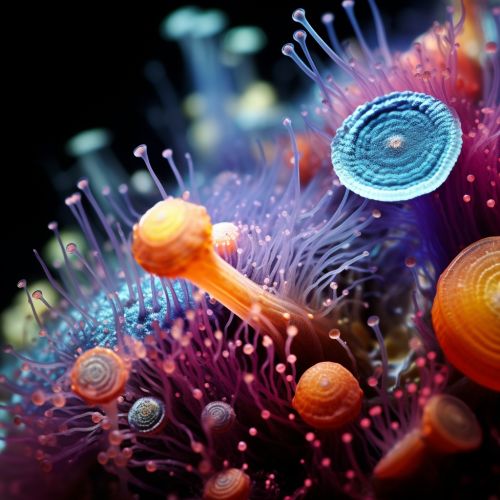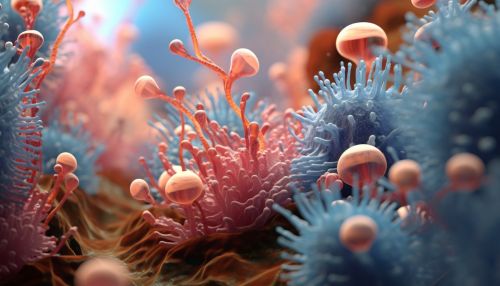Radiotolerant organisms
Introduction
Radiotolerant organisms, also known as radioresistant organisms, are life forms that can survive high levels of ionizing radiation. This unique ability is not found in all organisms and is often associated with extreme environments. The study of these organisms provides valuable insights into the mechanisms of DNA repair, cellular protection, and survival in extreme conditions.


Characteristics of Radiotolerant Organisms
Radiotolerant organisms exhibit several distinct characteristics that enable them to survive in high-radiation environments. These include, but are not limited to, the ability to repair DNA damage, the presence of protective molecules, and a high tolerance to desiccation.
DNA Repair Mechanisms
One of the key characteristics of radiotolerant organisms is their ability to repair DNA damage caused by ionizing radiation. Ionizing radiation can cause a variety of DNA lesions, including base damage, single-strand breaks (SSBs), and double-strand breaks (DSBs). DSBs are the most lethal form of DNA damage, as they can lead to chromosomal aberrations and cell death if not repaired.
Radiotolerant organisms have evolved efficient DNA repair mechanisms to cope with these damages. For instance, Deinococcus radiodurans, one of the most radiation-resistant bacteria known, can repair hundreds of DSBs within a few hours of exposure to ionizing radiation. This is achieved through a combination of non-homologous end joining (NHEJ) and homologous recombination (HR) repair pathways.
Protective Molecules
Radiotolerant organisms also produce protective molecules that shield their cellular components from radiation damage. These include antioxidants, which neutralize harmful free radicals produced by ionizing radiation, and DNA-binding proteins, which protect DNA from radiation-induced damage.
For example, Deinococcus radiodurans produces a unique manganese complex that acts as a powerful antioxidant. This complex scavenges free radicals and prevents them from causing oxidative damage to cellular components. Similarly, the DNA-binding protein Dps (DNA-binding protein from starved cells) in Deinococcus radiodurans binds to DNA and protects it from radiation-induced damage.
Desiccation Tolerance
Many radiotolerant organisms are also highly tolerant to desiccation. This is because the cellular mechanisms that protect against desiccation, such as DNA repair and the production of protective molecules, also confer resistance to ionizing radiation.
Desiccation tolerance is particularly important for radiotolerant organisms that inhabit dry environments, such as the Atacama Desert or the dry valleys of Antarctica. These organisms can survive long periods of extreme dryness and then resume normal metabolic activity when water becomes available.
Examples of Radiotolerant Organisms
There are several examples of radiotolerant organisms, ranging from bacteria to fungi and even some animals.
Bacteria
Deinococcus radiodurans is perhaps the most well-known radiotolerant bacterium. It can survive doses of ionizing radiation that are lethal to most other organisms. Other radiotolerant bacteria include Thermococcus gammatolerans, which can survive high levels of gamma radiation, and Rubrobacter xylanophilus, which is highly resistant to both ionizing radiation and UV radiation.
Fungi
Several species of fungi are also radiotolerant. For example, Cryptococcus neoformans is a yeast that can survive high levels of ionizing radiation. Another example is Cladosporium sphaerospermum, a black mold that was found growing inside the Chernobyl nuclear reactor after the disaster.
Animals
Among animals, the most notable radiotolerant organism is the tardigrade, also known as the water bear. Tardigrades can survive extreme levels of ionizing radiation, as well as other extreme conditions such as high pressure, low temperature, and high salinity.
Implications and Applications
The study of radiotolerant organisms has several implications and applications in various fields, including astrobiology, radiation therapy, and biotechnology.
Astrobiology
In astrobiology, the study of radiotolerant organisms provides insights into the possibility of life on other planets. The ability of these organisms to survive in extreme environments suggests that life could potentially exist in similarly extreme conditions on other planets or moons.
Radiation Therapy
In radiation therapy, understanding the mechanisms of radiation resistance in radiotolerant organisms could lead to the development of new strategies for treating cancer. For example, if the DNA repair mechanisms of radiotolerant organisms could be replicated in human cells, it might be possible to increase the effectiveness of radiation therapy while reducing its side effects.
Biotechnology
In biotechnology, radiotolerant organisms could be used for the bioremediation of radioactive waste. These organisms can survive in highly radioactive environments and can potentially be used to break down and detoxify radioactive compounds.
